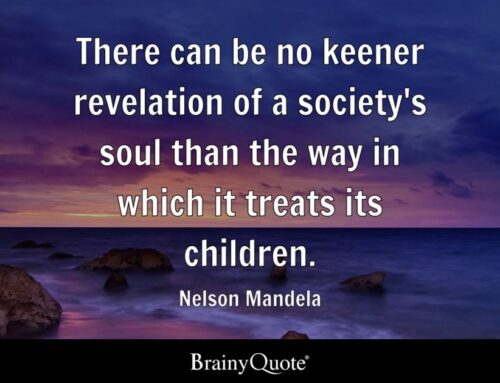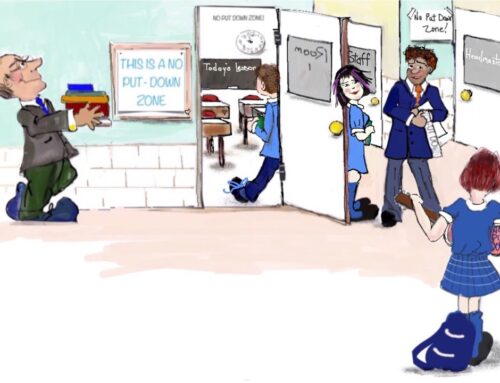This article addresses the following: the difference between stress and trauma, the sources and signs of trauma, protective and risk factors, the impact of trauma on families, the healing process, and when more help is needed.
1. The Difference Between Stress and Trauma
Stress is a temporary reaction to something which is usually within normal experience, e.g. going to the dentist, moving house, even the death of a close relative. Children may have strong emotional reactions to these events but are not usually traumatised by them.
Trauma is caused by situations which are outside normal experience, unpredictable and overwhelming. They result in feelings of terror and helplessness. The thoughts, feelings and images engendered by the event intrude into every day life and effects the ability to function ‘normally’. Trauma causes psychological injury with wounds that are hard to heal.
2. The Sources of Trauma in Childhood
Severe accidents: emotional reactions may be delayed while efforts are concentrated on physical healing and recovery.
Accidents are more likely to result in trauma if:
- there was a lengthy rescue operation
- there is disfigurement
- treatment involves many medical procedures
- others were killed or badly hurt.
Disasters and catastrophes: There are often many members of the community affected by such instances, and at times this results in positive support and reconstruction. It must be remembered, however, that each person’s experience is different – children will have different perceptions according to age – and that whole families and communities may be both physically dislocated and psychologically disrupted.
Events rooted in natural causes (floods, earthquakes) may be easier for communities to come to terms with than those caused by human irresponsibility, aggression or callousness.
Physical and sexual abuse: A single incident of physical abuse usually creates a different outcome than repeated abuse. Repeated physical abuse can lead to the most disabling and severe symptoms of post-traumatic stress.
Sexual abuse accompanied by threats, betrayal of trust, violence, injury or pain involves the most extreme psychological assault on children.
Interpersonal and community violence: Witnessing acts of violence against a loved person may result in severe signs of post traumatic stress (even when there is no physical abuse towards the child).
Community violence has been described as living in a war zone. Even where there has not been direct witnessing of an event it may cause a traumatic reaction when the setting or individuals are known.
Single incidents: Being taken hostage, being trapped, being attacked by an animal, are all examples of situations which are unexpected, result in terror and helplessness, and can result in traumatic stress reactions.
Witnessing events: Observing accidents or violence means that the child’s attention has been entirely focused and s/he will have very vivid memories of the scene witnessed. The more ‘personal’ the event the greater is the potential for trauma.
Some situations may result in loss, family disruption, criminal proceedings and feelings of revenge as well as other trauma reactions. A child who has seen mutilation or profuse bleeding of a parent or other close person will have great difficulty with the bereavement process.
Retraumatisation: This can occur when a child has experiences following the initial trauma but linked to it e.g. medical treatments, court appearance, media intrusion.
3. Signs of Psychological Trauma
 When: Some children react quickly to an event, others may appear unfazed for a long time. Studies suggest that children are more likely to develop delayed responses when they have encountered severe trauma or experienced physical injury.
When: Some children react quickly to an event, others may appear unfazed for a long time. Studies suggest that children are more likely to develop delayed responses when they have encountered severe trauma or experienced physical injury.
Individual differences: Children display considerable differences in the extent and nature of their reactions to trauma. Adults may be surprised or alarmed by the varying ability of individuals to ‘cope’. It is necessary to be vigilant, however, as behaviours/reactions may be slow to emerge, and behaviours seen may not conform to what is perceived as ‘reasonable’. Section 4 looks at resilience factors.
Reactions and Behaviours
Fear and panic
- fear – terror is central to psychological trauma. The sense of self and safety is severely disrupted, children may believe that the original trauma will re-occur.
- heightened anxiety.
- hypervigilance – looking for signs so that they can be prepared. Children are not comforted by reason in the way older people may be.
- panic reactions to associated fears – these could be anything, it is how the child has perceived the event – and can include everyday activities or experiences such as walking down a certain street. Fears may generalise to include a wider range of ‘triggers’ e.g. from a fear of dogs to a fear of all animals.
- apparently unrelated fears, e.g. going to sleep, being alone, monsters, the supernatural.
- sensory triggers to panic, e.g. certain smells or sounds. Research seems to suggest that it is the youngest children who are most likely to have a powerful panic reaction to sensory triggers.
- startle responses – sudden tensing, shuddering.
- separation anxiety – common in all ages. Some younger children will not let a parent out of their sight for an instant. Older children may need support to do simple things that they were used to doing independently.
- denial – some children need to address their helplessness by not admitting to fear and seek ways in which they can continue to be ‘powerful’.

Sleep difficulties
These can include nightmares, night terrors (where the child is neither fully awake nor fully asleep) sleepwalking and sleep disturbances. The child does not usually have any memory of these strong fears in the night.
Regression
This is a way of coping under stress. The following may happen:
- loss of developmental skills, e.g. language may revert to an earlier stage. In extreme cases a child may become ‘mute’.
- loss of self-help skills – toileting accidents are common.
- loss of inner controls over aggression.
- decreased ability to self-comfort. This may lead to a reduced tolerance to frustration, impatience, overreactions to disappointments or perceived rejection. The child becomes both needy and irritable.
- the above may make the child to appear very fragile emotionally – likely to find the smallest thing overwhelmingly upsetting.
Intrusive thoughts
Children have repeated images of the most horrific aspects of the trauma. These can happen at any time and children do not usually say when it is occurring. It is very common at bedtime – when there are no distractions and the child is awaiting sleep.
Children may be driven to repeatedly play out the event and/or to tell their story. The capacity for pleasure in play diminishes. Play is characterised by repetition. Play and
re-enactment may involve other children negatively and there needs to be an awareness of this.
Personality changes
Changes can be temporary or long-lasting. Attitudes, thoughts, expectations, self concept etc are all open to change.
Child may become pre-occupied – this leads to behaviour sometimes labelled as selfish or uncaring. The ability (and energy) to deal with disputes, show caring to others and react with patience or good humour are all diminished
There may be a corrosion of trust leading to suspicion, negativity and wariness.
Some children may become very withdrawn. Everything seems too risky, including play.
Children may lose a sense of optimism and hope – they may have a foreshortened view of their future.
Changes in personality may be temporary and lessen considerably over time. Children are more vulnerable to permanent changes if the trauma was severe or repeated.
Physical complaints
Overreactions to and complaints about physical pain may be a way of expressing psychological hurt. This may be more true of younger children or others who do not have ways of articulating psychological distress. Children may also become very attentive to bodily concerns as a way of channelling fears and energies.
Misinterpretations
The younger the child is the more likely s/he will seek and accept irrational or impossible explanations for events. An egocentric interpretation characterizes the thinking of all young children until the age of around seven. This commonly leads to self blame and guilt. However, this may also be true of older children. Sometimes any explanation is more acceptable than none. Many children keep these thoughts to themselves and adults are not aware of the interpretations that are being put on events.

Recklessness
This behaviour is most common in children where the trauma involved physical injury to themselves or others. Children may find themselves having an increased number of ‘accidents’
Anniversaries
Occasions such as anniversaries, birthdays, changes of season, holidays may retrigger trauma reactions. This may happen for many years and may occur without the person realising why they are feeling as they do at a certain time.
4. Protective and Risk Factors
The Child:
Protective Factors include:
- basic adaptability as manifested in earlier experiences of more minor difficulty.
- intelligence and the ability to reason (and esteem-promoting success in school).
- self-concept, self-confidence, the view that they can effect change.
Risk Factors include:
- the extent of demands already put on the child.
- emotional health just prior to the incident.
- resources used up in coping with developmental stresses.
Age and gender
Young children may not have the language or cognition to fully understand or express what has happened to them, but this is not a protective factor in many instances, as evidenced by play and other behaviours. They are also more vulnerable to events affecting a caretaker. Although older children have more problem-solving abilities, they may also be able to more fully appreciate the implications and devastation caused by an event.
 Girls tend to be more resilient than boys during early and middle childhood, but more vulnerable in adolescence.
Girls tend to be more resilient than boys during early and middle childhood, but more vulnerable in adolescence.
Behavioural manifestation is also gender related with girls responding more inwardly than boys.
The Family:
Protective Factors include:
- close and loving relationships where members are warm and supportive to one another. Even in families where there is conflict, a positive relationship with one person is sufficient to act as a ‘buffer’.
- acceptance of post-traumatic stress symptoms without demands to see a quick resolution.
- Positive role models in dealing with stressors. Adults who demonstrate a range of useful and positive ways of dealing with difficulties.
- A strong extended family (and/or friends) support network.
Risk Factors include:
- families where there is prolonged emotional turmoil / parental conflict, substance abuse.
- isolation from community support.
Aspects of the Trauma:
Duration: Single events of long duration are more traumatic than those which are briefer.
Threat: risk is greater when events are malicious rather than natural and where the situation has been potentially life threatening or perceived to be so by the individuals involved (to themselves).
Involvement of caretakers: either as victims or as perpetrators. This increases the child’s psychological harm and threatens their security on many levels. They are also possibly denied a safe place in which to begin healing.
Temporary or long-term physical injury: Disfigurement, hospitalisation and frightening medical procedures can repeatedly rekindle a child’s anxieties and traumatic memories.
The child’s perception of outcome: If the child feels that the traumatic incident is responsible for many negative outcomes and life changes, then they are more at risk than children who see the event as a single incident only weakly linked to other outcomes.
Disruption in caretaking: If the trauma results in the loss or many disruption of the main caretaking environment then recovery can be complicated by loss and chaos.
Making Judgements about Resilience
Children’s resilience is the outcome of many interrelated factors. It may be that children react in ways that are unexpected. For one incident there may be children who appear to have minor, relatively short-lived reactions and others who are more severely affected over a much longer period.
Some children may appear to be ‘coping’ and have few ‘external’ reactions, especially soon after the event. They may, however, be struggling with reactions ‘internally’ and it requires sensitivity and careful observations to identify their particular needs.
5. The Impact of Trauma on Families
Parents, siblings, grandparents, teachers and other carers are often the ‘hidden’ victims of a child’s trauma.
Support may be available in the short term but then families/carers are left to ‘get on’ with their lives and may feel abandoned or isolated.
The reactions of other family members will depend on their own coping mechanisms but also on the other events that are current whether these are positive or negative such as recent bereavement or marital tension.
Reactions of caregivers:
Faced with a trauma involving their own child, parents are forced into thinking the unthinkable and feeling the unbearable. Their own childhood fears, fantasies of being helpless may be reawakened
First concerns:
May be about the child’s physical well-being
Giving nursing care to a terrified child is unfamiliar.
It is not always easy to recognise signs of fear.
Fear may be the emotion that permeates the early days after the trauma.
Unusual changes in the child’s behaviour/demeanour exacerbates parental fear.
Fear may become panic if parents anxiety over long term effects increases – this may affect everyday coping.
Parents need to be encouraged to take one day at a time.
Later on: Disorganisation, distraction and disruption are common. Even managing small tasks sometimes seems impossible, parents may be on ‘automatic pilot’. Sleeping and eating patterns are disrupted, there is a loss of alertness. Expression of feelings may not be easy with consequent feelings of isolation. Parents may be disturbed by these changes in themselves, e.g. becoming very angry at small things, losing their normal ‘control’.
Often parents find that some of their beliefs about the world have been shaken. It is a threat to a view that conscientious parenting will keep their child safe. The world may seem random and meaningless.
Guilt is common – the words ‘if only’ characterise how a parent may view the incident. Sometimes parents are responsible and this can have severe and complex emotional consequences for the whole family. Professional help is essential in these instances.
Sometimes trauma reactions in a family can develop in a seriously negative cycle which may involve alcohol or drug abuse, loss of income, reduced immunity to disease and so on. It is not uncommon for marital relationships to break down. It is essential that parents attend to their own needs for the benefit of the rest of the family.
Misperceptions: Parents may need to reassure themselves and will be looking for any sign that their child is ‘all right now’. The opposite is also true, and parents may interpret everything as a sign of continuing trauma reaction. Both of these are coping mechanisms. Sometimes discussion with a more objective observer may be helpful. The child needs to have their current feelings acknowledged rather than overdramatised or minimised.
Reactions of siblings:
Parents are likely to notice signs of stress in other children in the family.
Intensity of reactions will be linked to the severity of the trauma and the relative family disruption it causes. The most severe reactions are from siblings who have witnessed a brother or sister’s trauma.
Some children may feel alarmed by parents’ anxiety or depression, others may feel responsible for causing or not preventing the incident, there is also the shock of awareness that it could have happened to them.
Some children will feel neglected, as parents cannot give them the same quality of time and attention as before, they may also feel jealous. This may result in attention seeking behaviours.
Parents may be surprised to find symptoms similar to those of the child who experienced the trauma – clear and consistent limits need to be set on trauma-related play so that it is not too anxiety provoking for siblings.
Relationships between siblings are not always straightforward and may be volatile. Feelings after a traumatic event may therefore be complex.
Siblings needs to be able to talk about the situation and share their feelings and reactions with parents and/or other adults.
What Children Need from their Parents
A sense of calm and as much normality as possible
Expectations and encouragement of feelings of distress
The capacity to seek out and accept help
Parents who resume their roles of authority and protection fairly rapidly.
Acceptance that full recovery may be a slow process
6. The Healing Process
Children look first to trusted adults for support. When the relationship is new the trust will need to develop over time.
This means:
- Being available on a regular basis – physically and emotionally
- Responding to needs
- Being consistent
- Establishing appropriate boundaries
- Making appropriate demands and having appropriate expectations.
Children can be rejecting – it is important to have someone to talk things over with so that you can have an objective view of what is happening.
Trusted adults have a vital role in children’s recovery in the following ways:
 Providing comfort and reassurance: Comfort to relieve bodily tension is important and this will differ according to the age and particular likes of the child. Soothing experiences such as cuddling, rocking, backrubs, foot massage, music and stories may all be helpful.
Providing comfort and reassurance: Comfort to relieve bodily tension is important and this will differ according to the age and particular likes of the child. Soothing experiences such as cuddling, rocking, backrubs, foot massage, music and stories may all be helpful.
Special comforting at bedtime: Some children will need parents to lie down with them for a while. Extra attention will not ‘spoil’ the child but if nightmares and fear of going to sleep continues for several months further advice should be sought.
Information: Children will want to hear what happened in words they can understand in amounts they can digest. Following the child in this respect in important.
Expect regression: The child may look and behave as a younger child. ‘Babyish’ needs are apparent, sometimes babytalk, wishing to drink from a bottle, biting, hitting and bedwetting are common. Most of these behaviours will be temporary and should be tolerated. Reminding the child that s/he will feel stronger and safer and more grown up again soon increases confidence.
Respect a child’s fears: “I know you are feeling frightened of … I wonder what we could do so you are not so frightened”. Reminding children both in words and with visual support that a fear may get smaller with time is helpful. Seeing adults taking these fears seriously but not being overwhelmed by them is also reassuring. There should be no expectations that the child will be ‘tough’ or ‘brave’, but expectations that they will feel better in time.
Providing help for flashbacks and panic: Gentle guidance back to awareness of the present is helped by:
- physical comfort and contact – a special object to hold
- talking about the here and now, reminding the child that s/he is not alone
- asking the child to identify sights, smells and sounds in the immediate vicinity. Tasting something might help
- instructing the child to breathe deeply can help them to relax and refocus
- encouragement to express feelings about the trauma
- reminding the child that the pictures in their head are like a video, they are no longer in the here and now and that like watching a film they are now safe
- after flashbacks children may be drained and need to rest or sleep
Talking about feelings: Children can deal with their feelings in several ways: playing, acting them out through various behaviours, struggle in their dreams, or talk about them. This is not easy and most difficult for pre-schoolers.
Adults need to be aware of when children need to express emotions and acknowledge and accept these without further input except reassurance.
This isn’t easy, there are feelings we would prefer children did not have, many feelings are uncomfortable or disturbing to hear, there is a temptation to add advice or be critical – this may stop the child from speaking again.
Expect frequent re-telling of the event: Children will find progressive relief over retellings. This may be hard for adults to tolerate but it is very much part of the healing process.
Provision for play: Re-telling the trauma in play is likely to be frequent and intense immediately following the event. Some children may want adults there, others, usually older, may require privacy. Toys that help in this process are useful depending on the event: toy police cars, ambulances and so on.
Limit and monitor the play of victimised children: Playing out roles may occur in an extreme way and may scare other children. Pretending the role of a powerful aggressor or insisting on always being a victim needs some adult intervention. Behaviour which is aggressive or sexualised should be stopped. Consistent but quiet and calm intervention in which the child is told that this behaviour is unacceptable is the best way of dealing with it. Shaming or blaming children is not helpful.
Expect difficult behaviour: Children’s self-control often fails them in both minor and more serious ways. Rules and boundaries provide security, and should be gently but firmly maintained. However, keeping confrontations and conflicts to a minimum means less stress for both child and adult. Longer term behavioural difficulties require external support. The child who feels guilty about his/her part in the trauma may provoke situations in which they are punished.
Communication: It is helpful for all those who work with the child to be aware of the situation. Home/school liaison is particularly important.
Maintain routines: It is useful for familiarity to be maintained. Anything that is new, challenging or difficult should be postponed. Routines, however, may need to adapt to the needs of the child where necessary, e.g. if the trauma involved a journey by bus and buses generate fear they should be temporarily avoided.
Monitor and limit exposure to frightening situations or activities: This requires awareness of potential triggers. Sometimes something unexpected will panic a child, who may react quite violently. It is helpful for the adult to be calm and help the child identify what it is which has caused such alarm. Many children, however, keep testing themselves out by re-exposure to fearful situations. They may need help to identify which activities will support their quest to regain mastery and which may be overwhelming.
Investigate the causes of sudden regression or fear: Think over recent experiences, ask teachers about what has been happening at school. Simply talking with the child may help or encouraging communication in pictures or stories.
Provide physical outlets: Activities which are fun and use up physical energy are helpful in releasing tension. They are also useful in controlling anger.
Awareness of anniversaries: These can be triggers. Even seasonal signs such as a change in the weather may cause a reaction.
Awareness of distortions and misunderstandings: Clues can often be found in a child’s behaviour. Exceptionally ‘good’ behaviour may be driven by a belief that the trauma was caused by some ‘naughtiness’ on the part of the child. Older children may not always maintain a logical view of causality and still have ‘magic’ thinking when they attribute events to such things as the power of their own thoughts.
7. Working with the Phases of Healing
These phases are usually sequential but do not necessarily follow a straight line. Progress may be uneven. Children may need to return temporarily to an earlier phase. As they get older and more able to understand they may revisit issues to place them in a different context.
i) Crisis response:
Extremes of distress, numbness, hyper alertness, dread, fear for safety, need to re-establish normal patterns of eating and sleeping.
Children in this phase need comfort and reassurance that they are safe.
ii) Remembrance and mourning:
Finding ways to acknowledge the reality of the trauma and its impact.
The wish to forget is in conflict with frequent re-emergence of unwanted thoughts and feelings. Pain, anger and loss are inevitable.
Inner turbulence is often most evident in disturbed and disturbing behaviour – nightmares, re-enactments, determination to seize control of every situation.
This stage also involves trying to put the event in a rational framework. Children have to readjust their concept of themselves
Extraordinary and shocking events appear to take time to be assimilated into ordinary memory and may need help to do so.
As children move through this phase they are more able to make reference to the traumatic event and tolerate reminders without experiencing overwhelming distress
Children in this phase need help with the turbulent process of remembering and mourning. H/she needs to know that feelings experienced are normal and that trusted adults are there to help. Talking, playing out memories and feelings need to happen without causing obvious alarm to parents and other adults
iii) Readjustment and return:
This phase is marked by re-engagement with ordinary life. There is more connection with the present and future and less emphasis on the past. The child is able to feel pleasure, competence and a sense of control and the normal experiences of childhood continue to nurture the recovery.
In this phase children need encouragement and support to move on and re-connect with life, normality and the world outside of their traumatic experience.
8. Self-Care for Parents and Other Adults
Acknowledge your own feelings: Strong feelings will be engendered and need attention. Children need calm adults who are available to them for support and reassurance – this can be very difficult to achieve. Parents may need to talk with others to maintain a balanced perspective, reduce their own distress, remain empathetic without being overwhelmed. There also needs to be awareness of exhaustion. Other adults will need to be mobilised and professional help sought if necessary.
Self-talk: Some self-talk promotes coping and creates energy to solve problems. At other times this can be negative and inhibit recovery. Parents need to pay attention to the messages that they are giving themselves. Are these full of statements of inadequacy, blame or helplessness or are they focusing on ways in which things may be made better. Do they look forward positively?
“This child has been hurt and frightened, she is behaving in ways which are understandable, she needs time to recover and heal.”
“Terrible things have happened but dwelling on these every minute of the day will not help my child or me to begin to feel better.”
Focusing on images of strength: Children need to be reminded of their strengths and competence in as many ways as possible: this will decrease their feelings of helplessness. Parents also need to hold onto positive images of themselves – remembering times they had got through difficult or challenging situations. Images of peacefulness can also be useful. Recovery from trauma has a great deal to do with hope and endurance.
9. When More Help is Needed
Indicators that the child and/or the family need professional support include:
- behaviour that is endangering to the child or others. This behaviour can be physically dangerous or emotionally very frightening. When the child has many accidents, this may be linked to a desire to inflict harm on him/herself.
- expression of a wish to die and to be heavily absorbed in issues to do with death and dying, threats of suicide. This could be linked to guilt, a wish to rejoin someone who has died or to escape the present reality.
- when the previous grasp on reality is lost and the child is having difficulty distinguishing between fantasy and reality. This can include relating events that have not happened, talking about hearing voices, incoherent speech or bizarre behaviour.
- where traumatic reactions are so severe or so numerous that everyday functioning is seriously impaired. Periods of normal activity are few and far between.
- parental anxiety and depression that is severe and disabling so that there is little hope for the future well-being of the family.
… and if the following last for longer than six weeks after the traumatic event:
- the primary focus of play and conversation continues to be the trauma.
- the child is continuously vulnerable to re-experiencing extremes of fear.
- initial regression continues unabated.
- the child experiences nightmares at least weekly and sleep disturbances continue at the same initial level.
- social withdrawal, lack of enjoyment in anything, high level of passivity continues.
- the child who frequently complains of physical pain for which no cause can be found.
- behaviours are causing serious deterioration in relationships.
- vivid terror continues to be experienced in response to sensory triggers.
- continued distractibility prevents attention to learning in school.
- continued focus on self-blame and ‘badness’.
- initial changes in personality continue to be dramatic and worrying.
- the child’s post traumatic reaction is particularly upsetting to the child.
- parental anxiety and confusion is preventing them from resuming a sense of normality within the family.
Although parents are less likely to go for crisis intervention, the earlier children go for help the better they will benefit.
Children can do the work of therapy through play – ‘talking’ therapy is of more help after the age of eleven.
*************************************************************************************************************
You can download a copy of this paper here: Children and trauma








Leave A Comment
You must be logged in to post a comment.